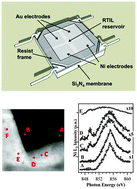Corrosion of Ni in 1-butyl-1-methyl-pyrrolidinium bis (trifluoromethylsulfonyl) amide room-temperature ionic liquid: an in situ X-ray imaging and spectromicroscopy study
Abstract
This paper reports a pioneering application of soft X-ray scanning transmission


 Please wait while we load your content...
Please wait while we load your content...